NOTE: This is one of those stories that’s probably more for me than many Zephyr readers. It’s about remembering a happy time in my childhood. It may resonate with some of you, or it may not. If you’re under 40, unless you’re among the dwindling few, it probably won’t, and that’s a shame. I wish it did. So, on the other hand, maybe you Millennials and Gen Zers should be even more interested—just look what you missed out on. And it’s never too late. Anyway, to those who recall that kind of childhood, I hope you’ll enjoy this little flashback—JS
I grew up in Kentucky, which is the “Cave Capital of the World. It has the largest and most extensive cave system on Earth. Mammoth Cave is one of the most visited national parks in America, and I was probably no more than seven or eight when my dad took us there for the first time. I was ecstatic; I’d never seen or imagined such a magical place. I became a “cave buff.” I read every story and book I could find on the subject. I learned that Kentucky’s vast deposit of limestone, created hundreds of millions of years ago, was the perfect geologic formation for the creation of a cave. Its mineral composition was easily dissolved by the action of water and consequently there are thousands of miles of cave systems in my home state.
I kept reading— I learned about my state’s “cave history,” and the tragic story of renowned cave explorer Floyd Collins, who discovered Crystal Cave and first realized how all these caverns were connected. He often explored alone and sometimes his enthusiasm got the better of his common sense. On just such a journey, Collins became trapped in a narrow passage, when the ceiling collapsed on his legs. The cave was so small he could not free himself. After a couple days, his absence was noticed, and rescue parties finally found him, still alive but in terrible condition. It became a national story, but all efforts to free him failed. Floyd eventually died of exposure. He was finally laid to rest in a nearby chamber. (For more on the story of Collins’ entrapment and death and the national publicity it generated, click here)
*****
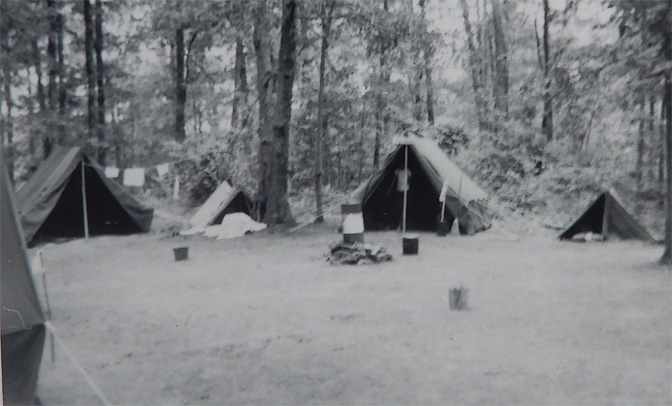
There were many other commercially managed caves to visit. I recall a Boy Scout trip to Wyandot Cave; though it was in southern Indiana, it possessed all the same geological characteristics. But being a kid, I somehow assumed that all caves were managed and regulated. The idea of an unknown cave, wild and unencumbered by tourists, park rangers, curio shops, and other oddities hadn’t occurred to me. But twice a year, my Boy Scout Troop 246 gathered with other Scouts from the area for a “camporee.” When I was 12, we all met at a farm that was perched on a ridge above the Ohio River. It was owned by a longtime supporter of the Scouts named Angus McTavish. Just his name alone was inspiring. But he loaned us his farm for the weekend and one afternoon, a couple pals and I went wandering. As we pushed our way through the brush, we followed a deer trail at the base of a massive limestone cliff. To our surprise, deep in the foliage, we discovered a cave. Its entrance was close to ten feet high and we were dying to explore it. But we weren’t equipped for such an adventure. Being daylight, we obviously didn’t bring a flashlight.
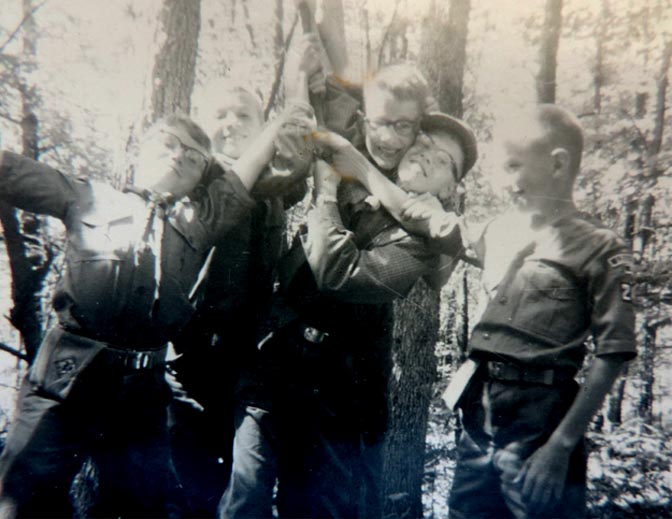
But one of my buddies, Steve Hotard, looked at me and smiled and said, “I know where there’s a cave, a wild cave, and it’s within walking distance of my house. But hardly anybody knows it’s there.”
“What? “ WHERE?” I exclaimed. I could scarcely contain myself. Hotard made the best of the moment, knowing he had some information I was dying to hear. But he was a good guy and could only torture me for so long. “You know where the Bullitt Farm is? Oxmoor?”
We all knew the Bullitts—they were one of the wealthiest families in Jefferson County. They owned a magnificent horse farm on the eastern side of Louisville. Just off Shelbyville Road. In 1962, it was still all farmland and forest.
“Do you really know where it is?” I asked.
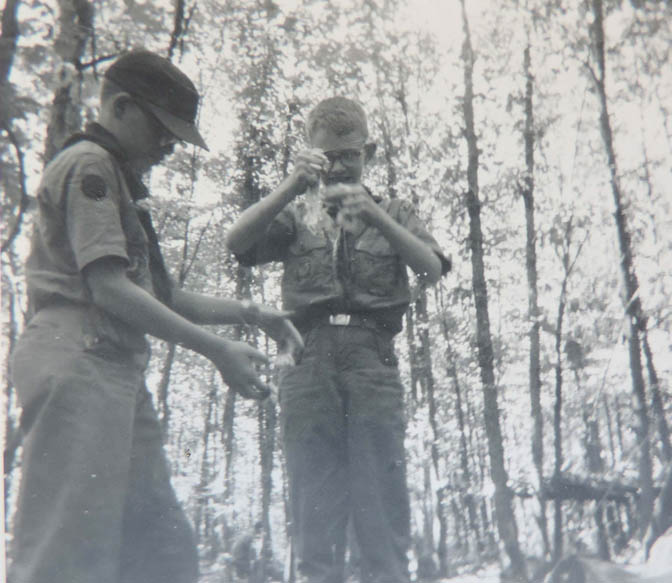
Steve smiled. “I can take you right to it.” We immediately started making plans. In addition to Steve, our buddy Jeff Dutton, a fellow Scout and member of the “Flaming Arrow Patrol,” wanted to join us. We made plans for a good weekend once school was over. One hot day in July, , we gathered at Steve’s home and climbed over his back yard fence into a sea of corn stalks. We were practically walking in the blind because all we could see was more corn. Finally a tree line appeared in the distance. Hotard said, “That way.”
We emerged from the cornfield into a huge pasture dead ahead and a magnificent forest to our right. Just a few hundred yards in front of us, I could see several small clusters of trees, like little forested islands. In fact, I can still remember there were four of them, in a row, each one perhaps a hundred yards from the next. “You see that fourth cluster? That’s it.” Hotard said.
From a distance, it looked like nothing. I was crestfallen. I was hoping for more. “That’s it?” I asked skeptically. “Just wait,” Hotard grinned. We came to the edge of the copse of trees and sure enough, Steve was spot on. We’d come across a sink hole; it was about 100 feet wide and maybe 40 feet deep. At the very bottom of this steep, but easily descended slope (we were 12), we saw a horizontal limestone ledge. It was perhaps 15 or 20 feet wide and at the opening, no more than four feet high. At the time I was barely four feet high, so I didn’t even have to bend over. Dutton was the gangly member of our spelunking team, but all he needed to do was duck a bit.
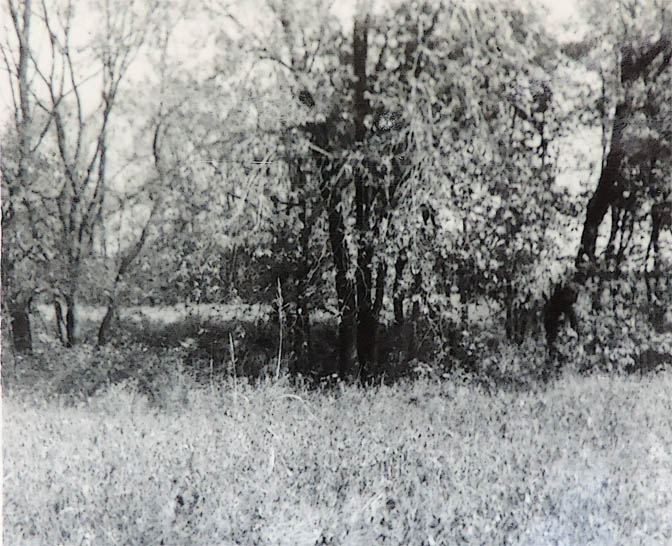
It was very much a living cave. Water was flowing through it, coming from a source north (or to the left of us). But the opening in that direction was too narrow for any of us, even me, to enter. None of us had expected the water, but we didn’t care. We turned on our flashlights, sloshed through the water in our tennis shoes, and ventured into the darkness. Almost immediately the height of the cave increased. At times the ceiling was almost ten feet high. Then it would get narrow again. And lower. And narrower. The volume of water stayed the same, but the passage grew so small, that we found ourselves up to our chests in running water. But we figured, as long as we kept our heads and
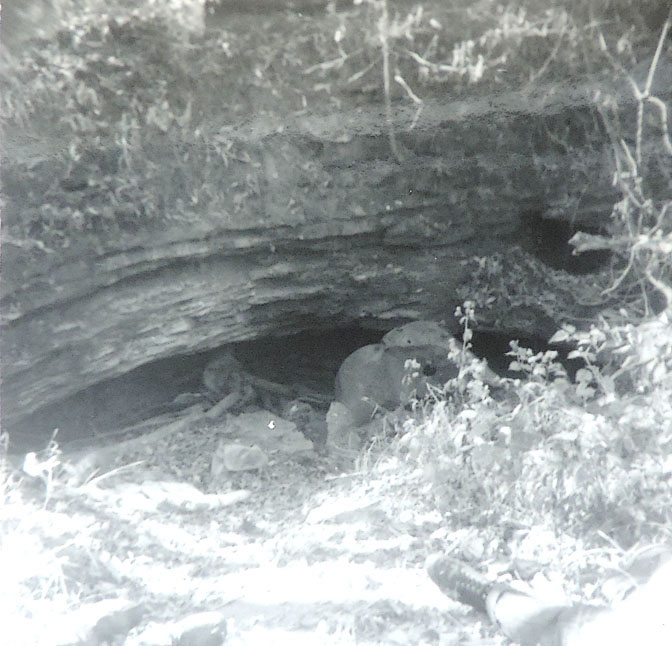
our flashlights out of the water, we’d be okay.
To reiterate—we were twelve.
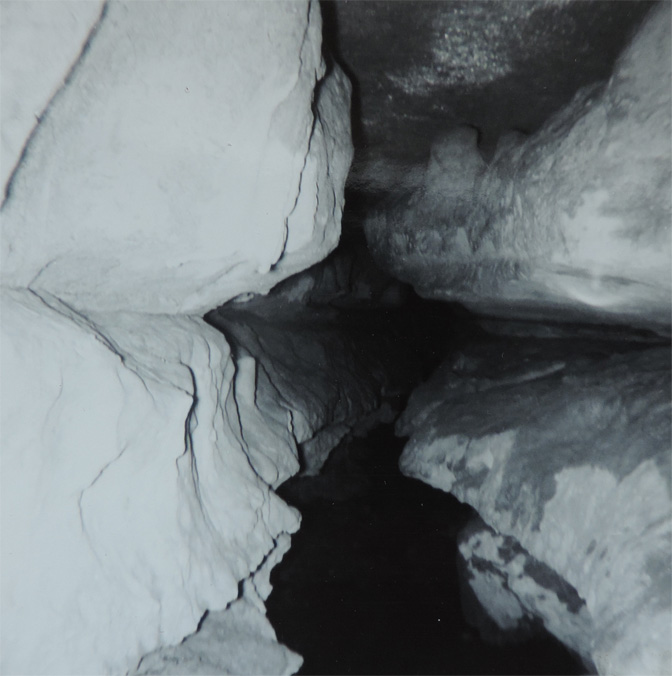
It was one of those days that a kid never forgets. We went back a couple times, but then my family moved to another part of Louisville and I briefly lost touch with my pals and with the cave.
My parents bought a bigger house closer to the city and suddenly I found myself in strange territory. I had grown up on the edge of Louisville, just adjacent to what was farmland— I was a Boy Scout, I hiked and camped, and paddled my canoe, and went cave exploring. Now my classmates were all city kids. Their idea of fun was to catch a Blue Motors bus on Bardstown Road, get off at Fourth and Broadway, and spend the day hanging out in department stores and the closest soda fountain. A few of them tried to turn petty larceny, i.e. shoplifting, into a contest. I tried to “join in,” but I didn’t have the nerve. It just wasn’t me.
And I liked a soda fountain Coke as much as the next guy, but I needed fresh air and trees. Then one Monday morning, I refused to go back to that school; after a week in hell, including a threat to send me to the truant officer and a facility for “juvenile delinquents,” my parents learned I could return to my old school and all my pals for $17 a month. My parents relented. Life was good again. (Years later my parents insisted that “giving in” had created an independent streak in me that could never be cured — like it was a disease.
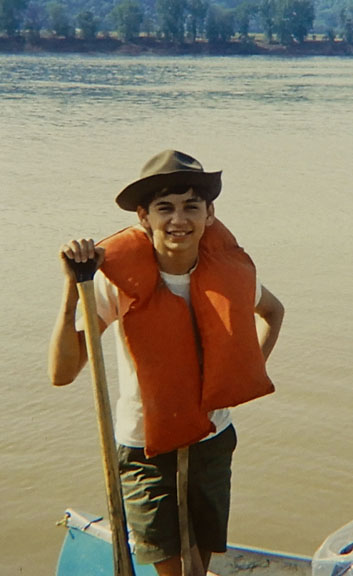
With my return to blessed Seneca High School, my buddy Jeff Dutton and I resumed our spelunking careers. I cannot remember what happened to Hotard. He either lost interest in caves or maybe his family moved away—I can’t remember. But Dutton and I were obsessed with Oxmoor Cave and it became a regular part of our weekends. Jeff, in addition to his spelunking skills, was an extraordinary model railroad buff. He would build entire towns from scratch, with tiny details that most of us would miss. I’d spend Friday nights at the Dutton family home and every week, I’d see what he had added to his incredible layouts. But on a regular basis, he’d get bored and tear it all down and start something new. I was almost in tears once when one particular small-town scene had wound up in Monday’s trash.
On Saturday mornings, we’d walk from his house, about three miles to the edge of the farm. But in the two years that had passed since our last visit to the cave, the damn highway department had extended Interstate 64, right through the middle of the Oxmoor Farm. Consequently the Bullitt Family’s access to Taylorsville Road was cut off. As a result, KDOT had to build a standard interstate highway overpass for their driveway. Now, instead of an easy and well-concealed hike to the cave, we were totally exposed to the Oxmoor Farm home, just a quarter mile away. Trespassing was about as wild as either of us got in those days, but we surely didn’t want to be caught. So it was always a mad scramble to cross that open ground and seek the cover of the corn crop, before anyone saw us. You’d think we were crossing Dog Green Sector on Omaha Beach.
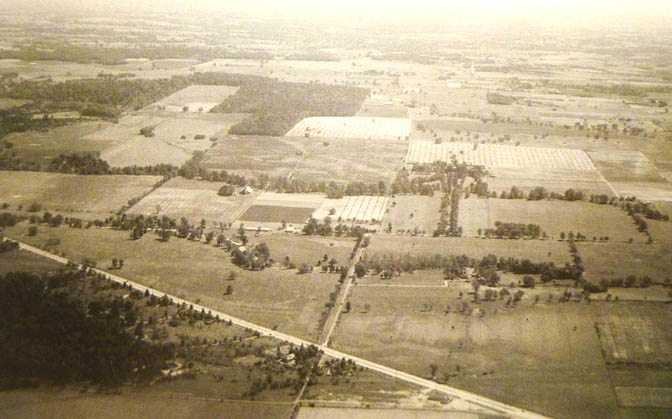
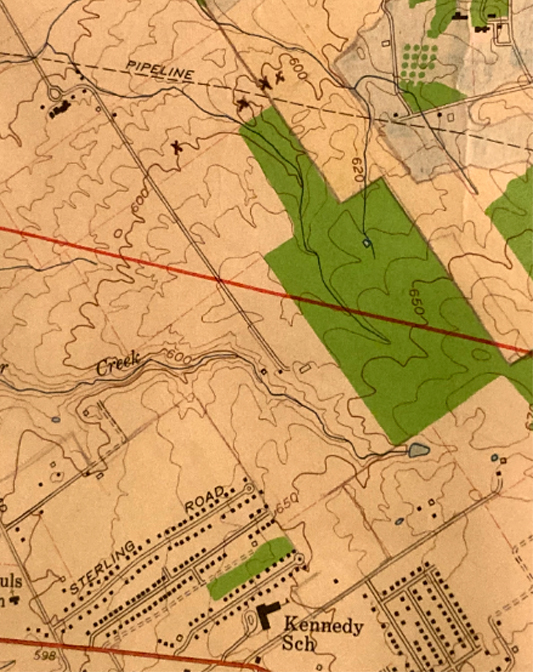
Once we got to the stand of trees that surrounded the cave and the sinkhole, we were safe. We’d spend all day there, sometimes camping out. We even thought we’d found a way to make a buck from our explorations. Dutton allegedly learned that the American Speleological Society was always trying to add to their cave database, and Dutton wrote for the forms needed to record Oxmoor. They would pay us ten bucks, but one of the questions on the form required a record of the change in temperature inside the cave from night to day. I have no idea how I convinced my father to agree to this—maybe he admired my entrepreneurial inclination. But he agreed to drive us out to the edge of the farm at two o’clock in the morning, so that we could record the nighttime temperature. He actually let us out of the car in a subdivision adjacent to the farm, and we had to run between two homes and hop their back fence. To this day, I can’t believe he agreed to this crazy plan. We dragged him out of bed and he made the ten minute drive in his bath robe.
We reached the cave in the full moonlight and set about taking measurements and recording the necessary data. We used a compass and a 50 foot tape measure to map the cave. Once underground it was always hard to get our bearings. Now I mapped out the direction of every straight section, took a compass reading, measured the number of feet, then took another measurement when the cave took a turn. It took us a couple hours but I jotted down all the numbers and when we later made it home, I drew a detailed map. Incredibly, all these years later, I still have it (see enclosed images). Though it was now 4 AM, Jeff and I felt good about our hard work and our professional speleological gifts. Then everything went wrong.
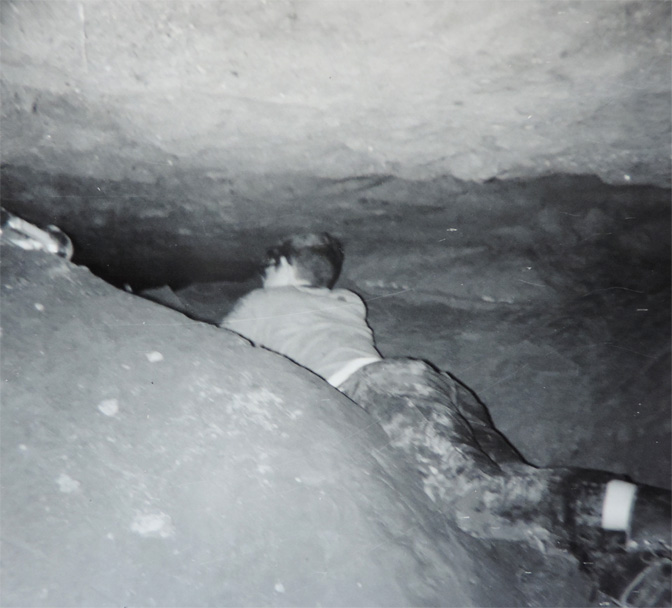
I checked the thermometer and discovered it didn’t work. And our batteries were getting weak and neither of us had brought extras. The cave itself was warmer than outside—we decided to make this journey in February — but it was very damp and we were chilled to the bone. When we emerged from the cave, we climbed to the top of the sinkhole, intent on building a fire.
“Give me a match, Dutton,” I said.
He stared at me. “I didn’t bring any matches; I thought you brought them.”
What? “How is that possible?” I complained. “You’ve got to be kidding me!” Somehow I thought it was his fault. Jeff gave me a scornful look.
“Hey Stiles,” he grumbled. “You’re the Eagle Scout. This is all on you.” Humbly I agreed.
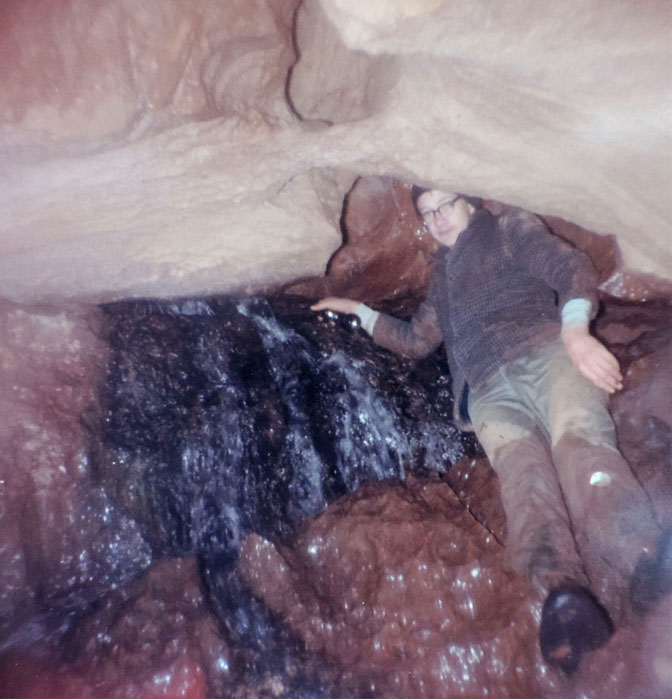
We were now in the early stages of hypothermia and our only option was to walk back to his house, four miles away, and hope we didn’t freeze up on the way. We made it, finally. His mom made us a big breakfast while we tried to warm up and rationalize yet again how we could be that stupid. Though we went back to the cave a couple more times, my father was done with 2 AM expeditions, we never got all the information we needed, we never mailed in our forms to the Speleological Society, never got our ten bucks and though we didn’t realize it at the time, it marked the end of our cave explorations. Suddenly our spelunking careers were over.
*****
As we got older, our focus and interests changed. I didn’t date much; I was still waiting to find at least one girl in my class who was shorter than me. I had to wait years. But Dutton and I continued our outdoor explorations, though we started staying above ground, and made the best use of the 15 foot fiberglass canoe my dad brought home one
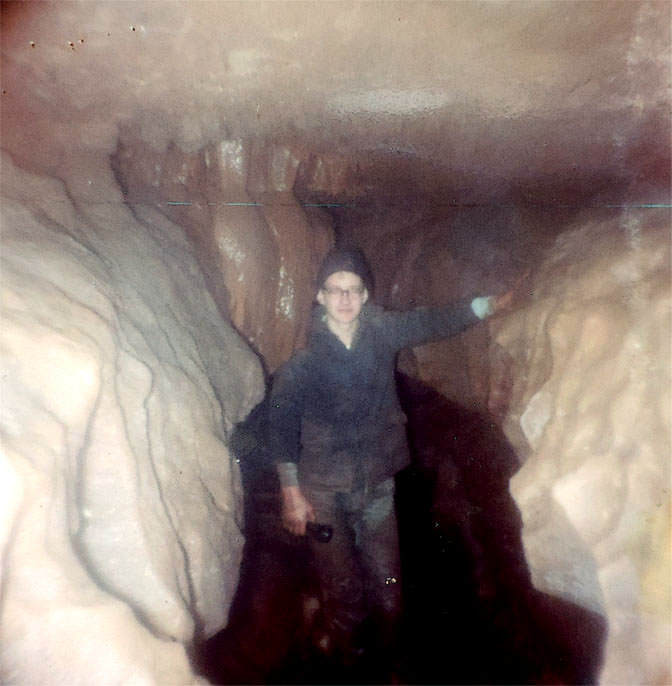
evening (another Sears return item that Dad acquired for pennies on the dollar). Dutton and I kept exploring, albeit in bright sunlight and with paddles, not flashlights. We still managed to inadvertently find unexpected and unplanned “adventures.” (“incidents” might be a more appropriate word). Our favorite Kentucky waterway, the Salt River, flowed through the middle of Fort Knox Military Reservation. We never gave it a thought, but on our first expedition, we unexpectedly came across a pontoon bridge; just beyond it, we could hear the roar of gunfire and artillery. Some of the rounds were going over our heads. We had somehow paddled into a “restricted area,” but nobody saw us. We stepped up our paddle pace, reached the Ohio River in good health and free of gunshot wounds.
A couple years passed, and after our high school graduation, Jeff and I took our first solo trip Out West (free from parental control). Our eight thousand mile, month long journey, took us to the bottom of the Grand Canyon, to Merced Lake in the High Sierras of Yosemite, to the Grand Tetons and even a two day float trip down the Snake River, in the shadow of the mountains and the heart
of Jackson Hole. It was supposed to be the “trip of a lifetime.” For me, it was just the beginning.
Jeff and I went to different colleges, started new lives and as it happens for so many old friends, we lost contact with each other. For decades I’d wonder whatever happened to Jeff Dutton. When I last saw him, he had accidentally left his Coleman cook stove in my car. I held on to it, thinking some day, I’d hear from him
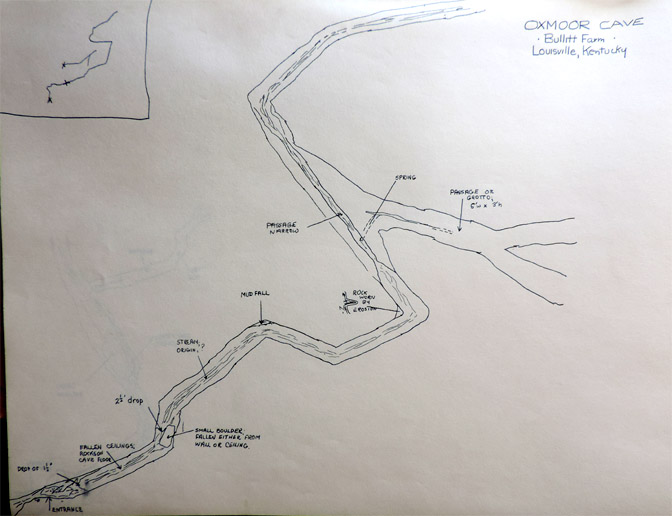
AND IN FUTURE YEARS…MORE ADVENTURES. BUT ABOVE GROUND MOST OF THE TIME,
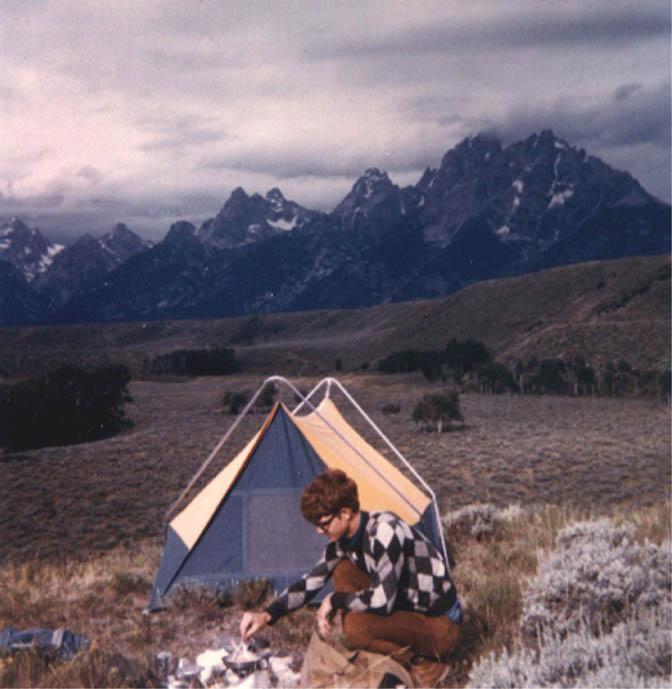
FIFTEEN YEARS LATER…I SEARCH for MY CAVE AGAIN
I lost contact with my cave as well. I moved to Moab, became a park ranger, rarely thought of my spelunking days, and only went back to Kentucky a time or two over the next decade, But in 1979, I decided to visit my family who now owned a farm in Henry County, north of Louisville. One morning I picked up the Courier-Journal and was rattled by a story that mentioned that construction of the new high end, “Oxmoor Estates” was progressing on schedule. The roads and utility infrastructure was complete and homes —the first of the McMansions —were being built at a rapid pace. Sales were brisk.
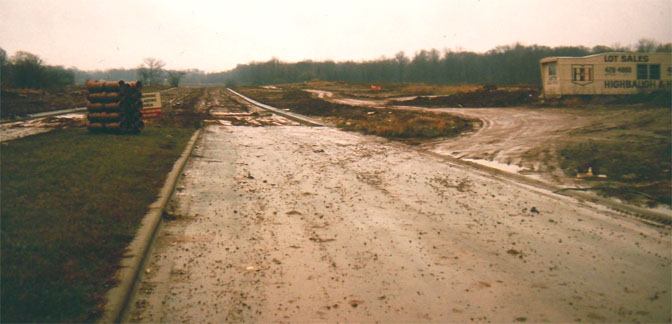
My masochistic side told me I had to take a look. Developers had already built the latest mall –the Oxmoor Mall! – at the junction of I-64 and Shelbyville Road. Now, on a rainy muddy morning, I found the new paved entrance and across what were once lovely corn fields and horse pastures. Houses were being built and in all stages of completion. But looking ahead, I could still see the forest that was adjacent to the sinkhole and my beloved cave.
Suddenly I slammed on my brakes. Though a big antebellum home was under construction just 50 yards ahead, to its right, still there and even accessible, was the Oxmoor Cave. Even the trees that surrounded the sinkhole’s circumference were intact. My friend Mike and I parked the car and I walked to the edge of the sinkhole. The cave’s entrance was still open, but workers were starting to throw their trash, chunks of concrete and sheetrock into the hole. And quite a few beer cans. Still the cave was there!
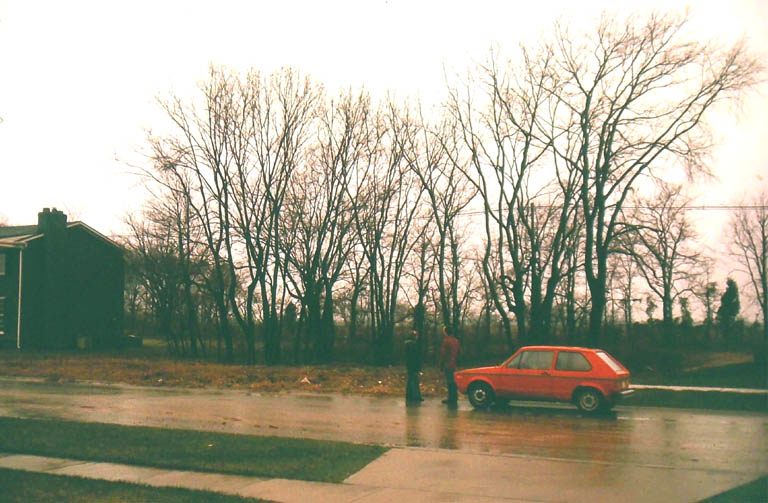
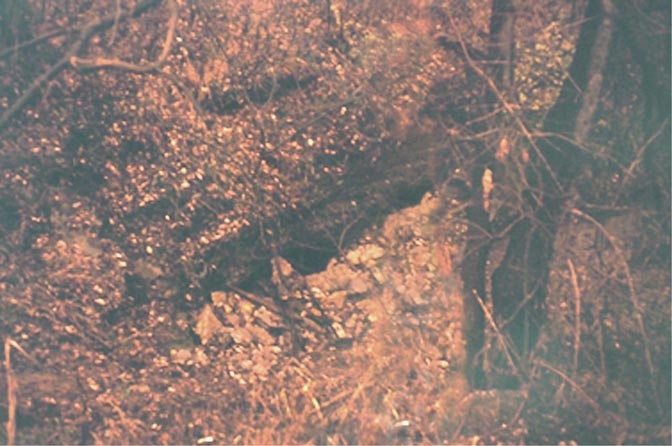
And remember, it was a living cave. Water was still flowing past its entrance end deep into the cave, just as it had 15 years ago. How could they possibly build a house over a cave that had year-round running water, just forty feet below the surface? Maybe, I hoped, the Bullitt Family, with its power and wealth, had insisted on its preservation. There would have been liability issues I suppose. But a tall chain link fence might keep most kids out (except kids like Dutton and me). We walked back to my VW Rabbit and I took one last photo of the stand of trees and the sinkhole. At the far left edge of that image is a nearly completed new home. Take a good look at it.
Almost twenty years later, I went back. The subdivision now looked like it had always been there. The homeowners had planted their own trees, which were now 30 or 40 feet tall. No one would ever imagine what this land had looked like when I was 12 years old. Incredibly the forest and fields beyond the cave were still there (not now, of course, but in the late 90s they had still escaped the sprawl). I could even see small clusters of trees in the field. But those were the smaller sinkholes I’d found decades earlier. Where was my cave? I finally gave up. Once again, the memory of the cave faded. But somehow it never went away for good.
AND NOW IN 2023…IN McMANSION WORLD
With the advent of Google Earth and Street View, it’s possible to go anywhere we want, or at least digitally hover over it. I love getting on Google and picking some empty piece of desert in the middle of Siberia, or zoom in on what looks like nothing but water in the South Pacific. The oddities I find out there are stunning —from tiny little islands that are uninhabited and probably never stepped upon by humans, to weird facilities in the middle of the Sahara Desert that convince me the Extraterrestrials are just waiting out there for the right moment to launch their invasion. Hiding in plain (Google) sight.
One day, the cave came to mind, and I thought I’d take a look. From the air, there was no sign of it. But then I remembered that photograph from 1979, when I last saw the cave. In that image, the house just adjacent to the sinkhole was nearly complete. Maybe, I thought, I could find that house. In the 1979 photo, I could glimpse its far north end— I could see a chimney, the northernmost windows on both floors. And I observed what appeared to be the very edge of a balcony that probably stretched across the front of the home. I decided to wander the neighborhood via Google Street View. The foliage from 40 year old trees made it hard to say with 100% certainty, but I believe the white house that appears here IS the house next door to the cave. And the house next door is sitting on top of my damn cave.
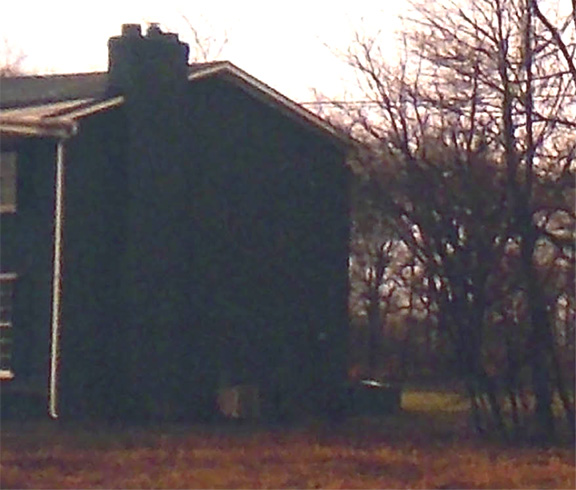
I suppose the value of real estate nowadays made the land too valuable to leave untouched. But how did the builders manage to build a very large home above a flowing living cave? It would have required a massive concrete wall of sorts, so impenetrable that it blocked the entire cave entrance and sealed the cave forever . They could not possibly have simply dumped more dirt and construction wasted into the hole. Eventually the water flow would have eaten away at it. And eventually the house would collapse into the sinkhole itself. As we all know from news stories over the years, such sinkhole home collapses happen fairly often. I recall a story from a few years ago, I think in Florida, where most of a house disappeared into a sinkhole and the owner, who was innocently sitting in his den watching television, vanished into the hole as well and was never seen again.
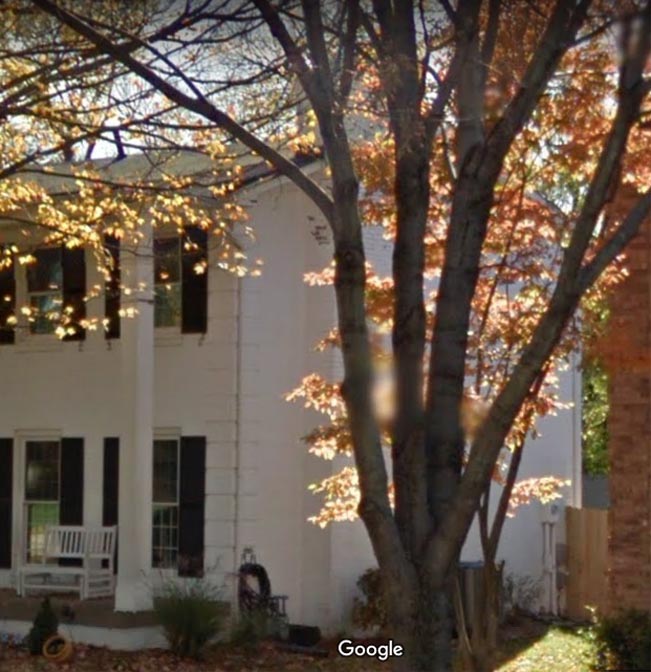
I do wonder if the current owners are aware of what lies beneath them, or if in the interests of full disclosure, the realtor told them. After all these years, the real history of that lot may have already been lost to history. Whoever lives there now will never know the beauty that still flows and lives, just 40 feet beneath their wide screen TV. And they’ll never know how much fun and excitement and misery and joy that cave provided us. But there’s one comforting thought — the Oxmoor Cave IS still there and surely looks almost exactly like the images in this story. Free from human intrusions, even 14 year old boys, the cave lives on.
I wish kids today had the same opportunities, or even the inclination, to have the kinds of adventures I had as a boy. If nothing else, they give me a constant source of topics to write about. (God, this is more fun than writing about politics!) In any case, I suppose those days are gone for most kids now. But as scary as that cave might seem to a mother or father today, I can assure you it was a lot safer than most urban areas, from coast-to-coast, are today. Still, my Oxmoor Cave is almost like a metaphor for my world —- the world I loved. Buried alive.
*************
A POSTSCRIPT IN PICTURES
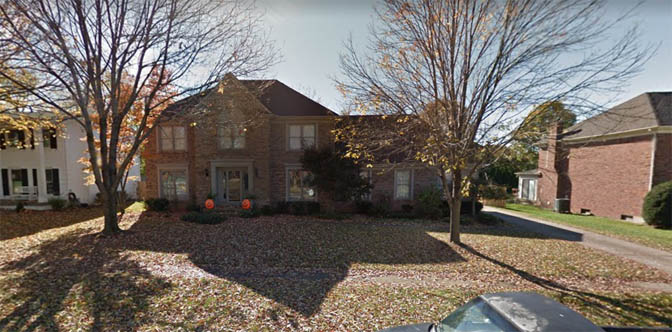


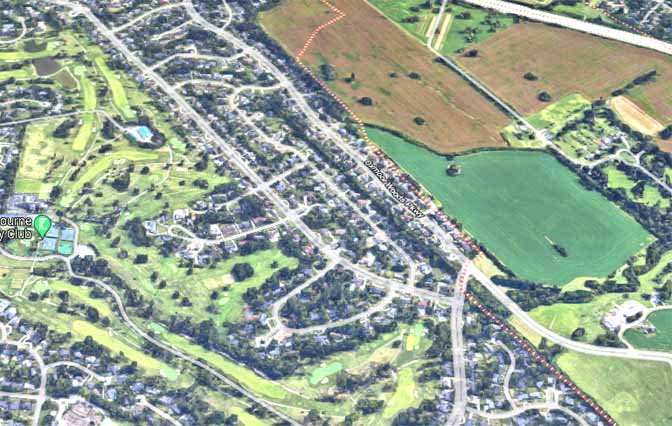
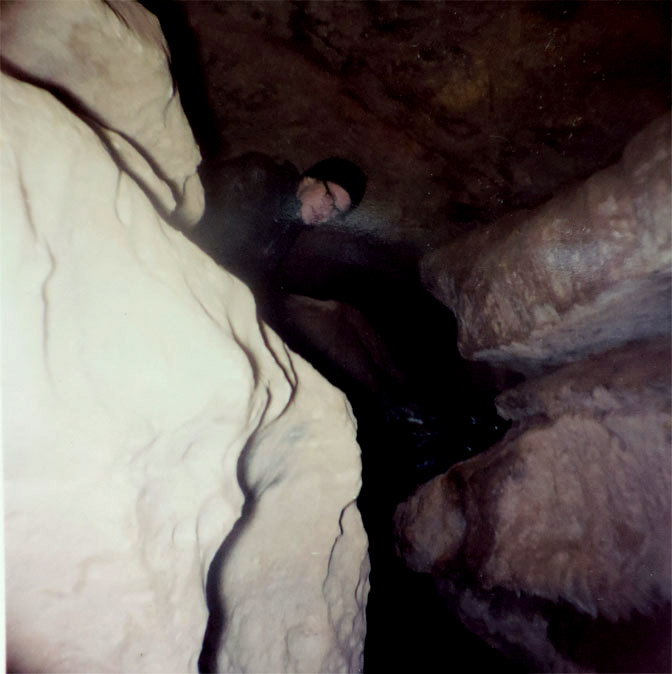
& my good friend, Jeff Dutton.
EPILOGUE:
I never saw Jeff Dutton again. But in 1995 a letter from Shawnee, Kansas showed up in my Moab post office box. These were the last years before the internet ruined us, and almost all my Zephyr correspondence, from subscriptions, to ad payments, to feedback letters, came to me courtesy of the US Postal Service. I had many out of town subscribers, even then, so I assumed it was just another sign up.
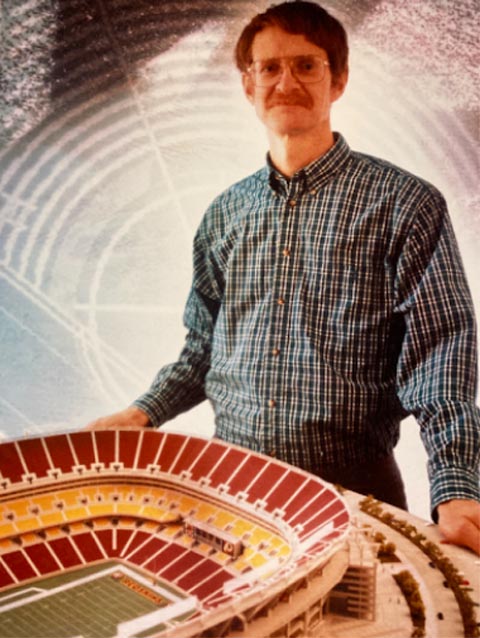
But it was a letter from Jeff Dutton. I can’t recall how he found me but it was such a great and welcome surprise. I learned that he and his wife Suzie, and their daughter Leah, lived in the Kansas City area. Even more uplifting was discovering that he had put his model railroading skills to good use and now owned a company, Omni models, that made architectural creations for large building projects. Baseball stadiums. Public arenas. Architectural designs of about anything one could imagine. Suzie worked with him for over 25 years. He had made a successful career and created his own business, doing exactly what he was most passionate about. How many of us can say that?
The Duttons made a trip to the South Rim in 1989, his first visit since our ‘historic’ first descent in 1968. But on the trail, Jeff struggled with his breathing, though he was only 40 years old. The next year, he went into cardiac arrest. Jeff was revived but he dealt with heart issues, including cardiomyopathy, from then on. Finally, in 1996, he entered a hospital to have a heart valve replaced and restructured. The surgery was a success, but while in the hospital, he contracted a staph infection and died a week later. Jeff Dutton was only 46 years old.
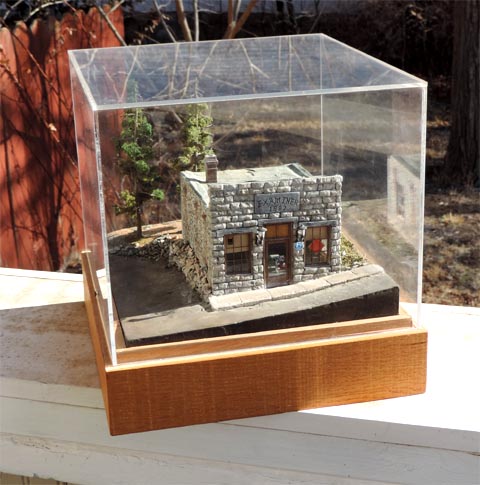
We had been corresponding and I had told Jeff I still had his Coleman stove. He said, “Oh yeah…I always wondered what happened to that stove.” We talked about a reunion, but then the letters stopped. Finally Suzie sent me a letter with the bad news. We have stayed in touch all these years. In the late 90s, she and Leah came out West, bound for the Grand Canyon, and asked if we could meet up somewhere. Near Kayenta, I met Suzie and Leah for the first time. It was a bitter sweet reunion by proxy. And she had a present for me. It was one of Jeff’s models–an extraordinary little recreation of a small newspaper office, “The Telegraph: 1882.” It is another of my most treasured gifts that resides in my living room, side by side with my favorite Herb Ringer remembrances.
Jeff Dutton was probably my first “best friend.” We were like brothers for a few years. Which means we also annoyed the hell out of each other from time to time. But he was also one of the few men in my life that I knew I could count on. He always had my back. After all these years, I still miss that gangly redhead. There was nobody like Dutton.
Jim Stiles is the founding publisher and editor of The Zephyr
TO COMMENT ON THIS STORY, PLEASE SCROLL TO THE VERY BOTTOM OF THIS PAGE…THANKS—JS


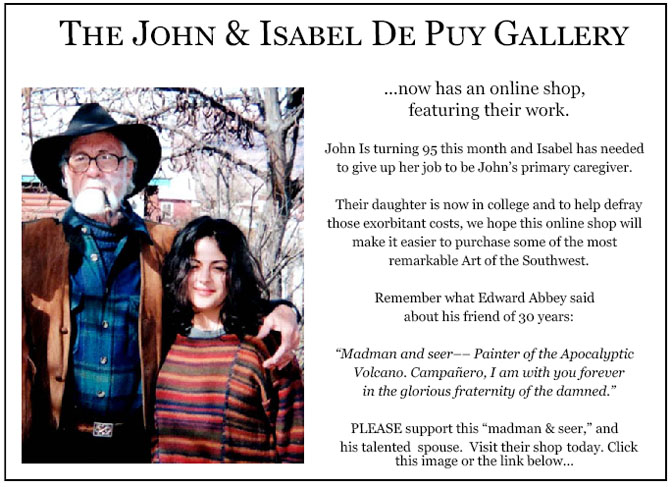
Thanks to them, our bills were almost completely covered.
Now I’d like to return the favor. Check out the link below and their online shop… JS
https://www.depuygallery.com/shop.html
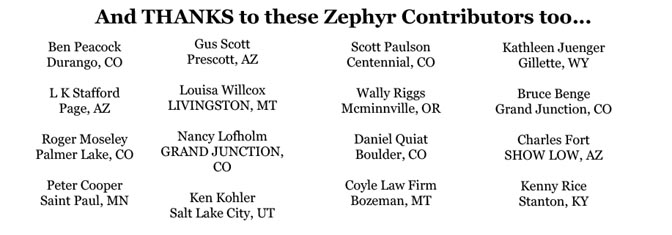

Why they can’t just leave the site alone is beyond me, but that’s what Facebook likes to do.
ALSO NOTE: I post old photographs and stories from our 25 year old archives every day. Pictures from Herb Ringer, Edna Fridley, Charles Kreischer.. even a few old photos from my Dad. So if you want to stay caught up on our amazing historic photo collections,
be sure to “follow” us on Facebook…Thanks…Jim
https://www.facebook.com/FansoftheCanyonCountryZephyr/

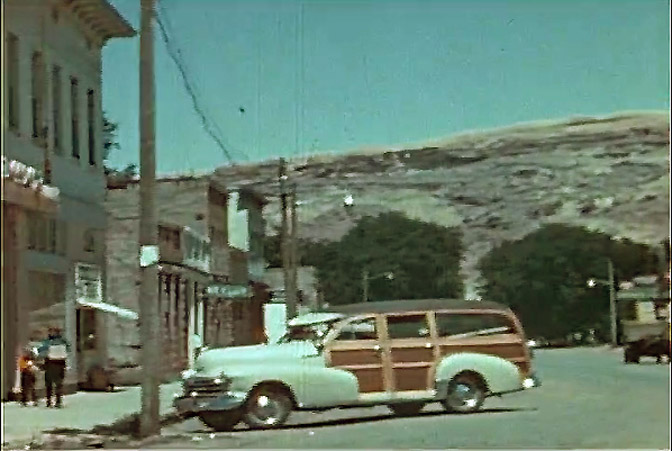
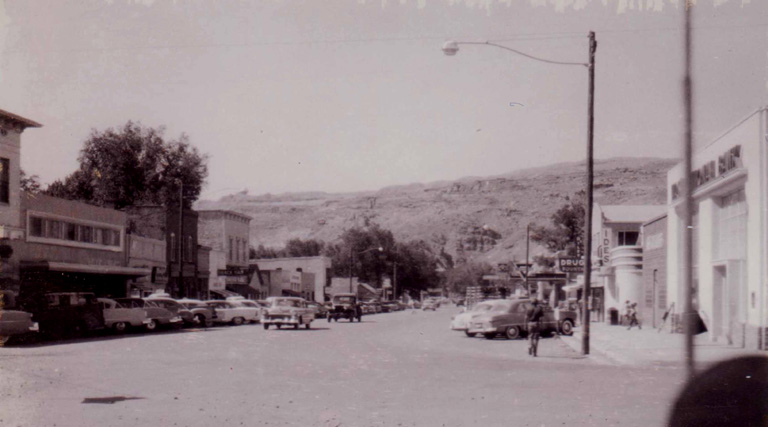
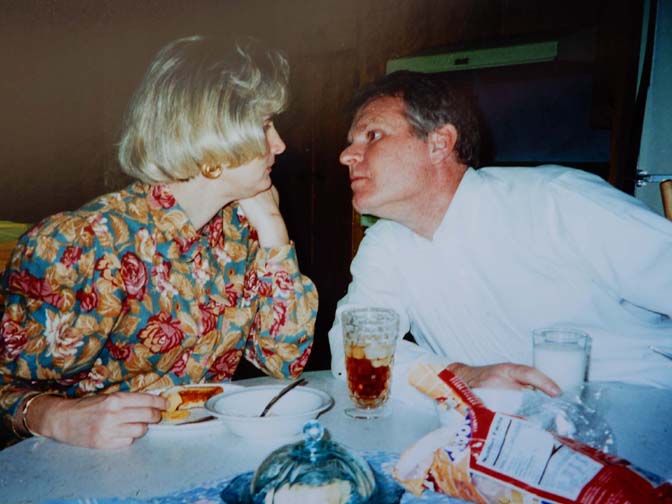
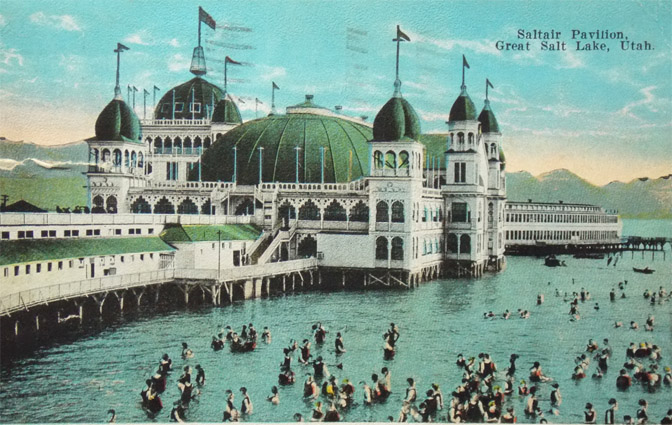
https://www.canyoncountryzephyr.com/2022/09/25/before-instagram-killed-the-postcard-1-classics-of-moab-vicinity-jim-stiles-zx28/
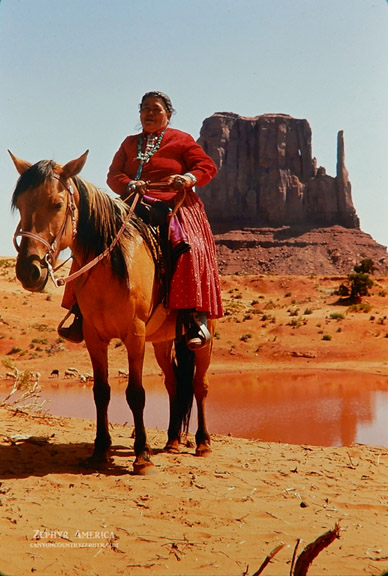
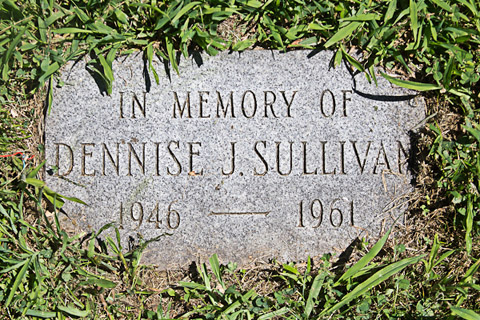
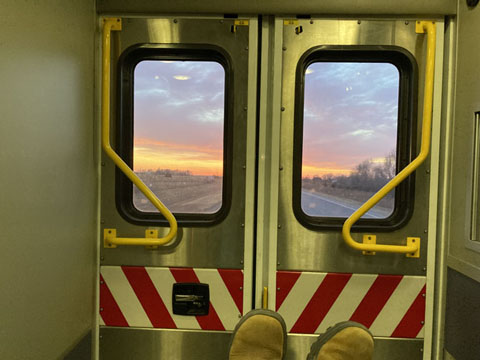



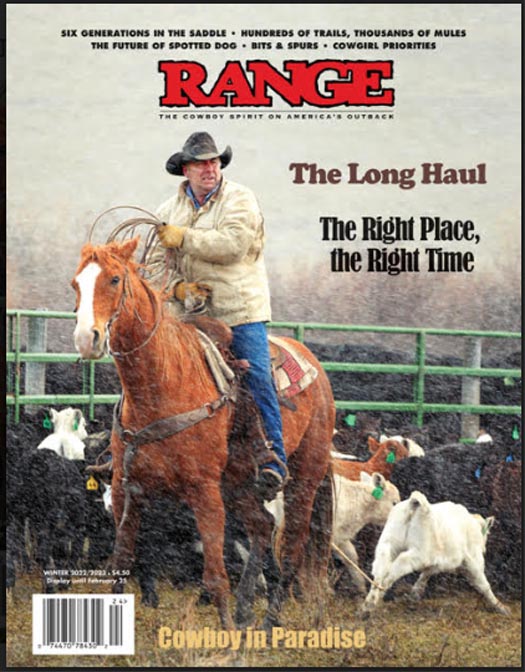

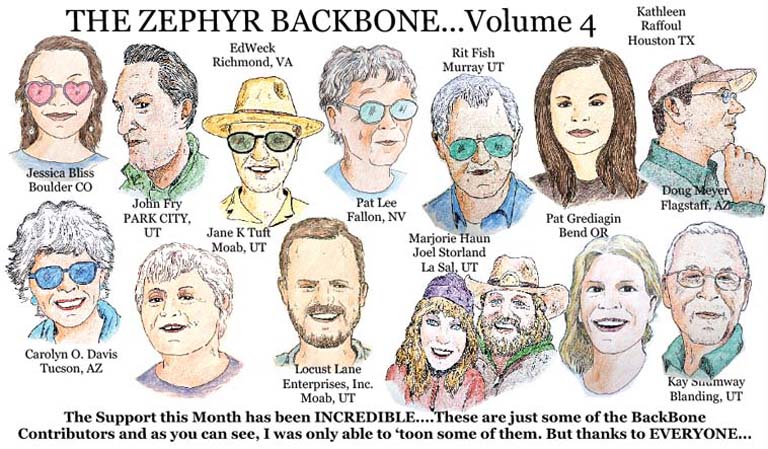


I grew up spelunking in such caves in central PA. Always uneasy underground, when I came across a passage (that previously had been a tight belly crawl) now wide open due to a collapse, something I always feared, I got out and have not gone underground for over 50 years.
When I was still married, Tonya and I went to Carlsbad Caverns a few years ago. I hadn’t been there in 30 years. It was spectacular. It’s so massive, you really can’t feel claustrophobic at all in some of those chambers.
Yeah Jim, I Lied, I did go to Lehman cave out by Great Basin NP, same feeling as Carlsbad and the route through is actually paved.
Great story Jim. Our generation is the last to grow up outdoors the way you describe. My best bud and I spent most of our time outside wandering in the woods, catching crayfish, etc. etc. It led me to backpacking, climbing and running rivers and I am grateful beyond belief that I got to grow up having parents who kicked me out early in the morning and told me to be home when the street lights came on.
Jim, I enjoyed your adventures and your ability to tell a good story is unparalleled. I had very similar experiences growing up. I do see a few of my grandchildren having good outdoor experiences and will try to find ways for my great grand children to learn to enjoy the wilds of nature at least in San Juan county.
Amazing story!! Jeff was my uncle and I remember him fondly for his gentle, calming and inquisitive nature. His modeling/artistic talents were something to behold growing up. I still remember a trip to Kansas City with my parents to visit Suzie/Jeff and Lea when I was around 13 years old. He took us into his basement and showed us the modeling world he had created from the depths of his imagination and his travels, it was amazing! Recently I took my family to RMNP in Colorado and passed through Kansas City on the way back. I tried to go visit Aunt Suzie but our schedules didn’t sync up. Even to this day I talk about Jeff and his passion for exploration and creativity to my wife and children. I think it’s what drives my wife and I to the mountains, cave tours and just being in the outdoors in general. As a consequence, we are trying to instill that same sense of the outdoors and exploration in our children. It is definitely a tough road! Again excellent read and thank you for providing more back story into my Uncle’s childhood, sounds a lot like mine! Feel free to e-mail me anytime.
Thanks Troy…Good to hear from you. I just responded in the comments below to your mom. Jeff was one of a kind. It’s odd for me to refer to him as ‘Jeff.’ He was always ‘Dutton’ and I was ‘Stiles.’ You’d think we never learned each other’s first names…I miss that guy a lot. As WC Fields once said, “The ranks are thinning.” He left us way too soon.
Jim, thanks for the memories. In 1959-60, my family lived in Oldham County, KY northeast of Louisville. Our home was in a rural area which provided great opportunities for exploring the local woods before suburban sprawl ruined the county. My parents took me to Mammoth Cave for the first time when I was 13, my 8th grade class at Liberty School visited a different part of the Mammoth Cave system a few months later, and when I was 16, two buddies and I took the all-day trip through the cave. Like you, it never occurred to me that there were 100s, if non thousands, of private, unexplored caves in Kentucky and southern Indiana. I’m sure that my Mammoth Cave experiences played a later role in my getting a geology degree at Ohio State University.
You seem to be getting rather nostalgic, stiles. Are you feeling the grim hand of The Reaper on your shoulder?
“Boy Scout Troop 246” sounds rather, how shall I say, nondescript. I was a member of 1st Eastcote from aged 8 as a cub until they booted me out, aged 18, from the Scouts. The smoking had become a problem. Still, in that time, I learned how to use a felling axe without slicing the skin off your shin and also how to make a pipe bomb: sodium chlorate, icing sugar (any sugar will do) packed into a metal tube – best to pre-drill the fuse hole prior to filling it. My brother did it the wrong way round but lived to tell the tale.
So, aged 18, I, and several other malingerers, were shunted up the road to 4th Eastcote Venture Scouts. This place, half a mile away, was much more free and easy: I rode my ’67 Bonneville, with straight exhausts, right into the hut to give a talk on ‘basic motorcycle maintenance’. All twelve of us were in awe of the fumes spouting from this legend of British manufacturing. Not once did we say ‘dib dib dob’ or spout the Scout Promise.
My first summer jolly with the 4th, ’82, was to mid-Wales, ostensibly to hike, count sheep and take in some fresh air. Of course, we the ‘committee’, had an ulterior motive: the mushrooms.
But before we got to look for any shrooms, we all had a go at crashing the rented van into gateposts, whatever. None of us was qualified to drive, apart from Chris Mason, our ‘leader’, who just held his head in his hands. It was a hot, dry summer and the psillies weren’t really happening in mid-August so I and a mate stayed on in this field for a couple of weeks.
Over the next few days, we picked a few and brewed-up. Word of WARNING – don’t ever visit a pub in mid-Wales when you’re spaced-out on psilocybin. The locals will make you feel paranoid.
The next year, ’83, the 4th Eastcote ‘Committee’, ie me, decided we should go on a cycling tour around Holland. You know, soak up the culture and all that. Well, within 30 minutes of hiring the bikes I’d cycled into a canal. That was before we’d found the pot.
I’m too drunk to type any more, Jim. I’ll read your article later.
Lake Foul elevation: 3524 with decent snowpack in the mountains. It’ll be interesting to see what happens. BuWreck reckons 3560 but what do they know?
I was born nostalgic.
Me too but nostalgia ain’t what it used to be.
How at the tender age of 12 did you have the presence of mind to take detailed photographs of these adventures? I wonder if the homeowners in the subdivision above the collapsed cave have any idea what lies below. This is a great read and an important account of a lost time and place.
I am Jeff’s sister. Marjorie, and this article made my day! Jim Stiles took the pictures, and I had never seen these. Suzie has kept Jeff’s large sailboat, and there are many adventures with his boat too. I was widowed 22 years ago, and remarried 16 years ago; so my first husband’s last name was Powers. My son is adventuresome just like my brother Jeff.
Thanks for your note…like I mentioned in the story, Jeff and I were just on the verge of reconnecting when he died. I still remember the absolute joy I felt when I realized the letter I received that morning was from him. I wish I could find it…you know he had a dry sense of humor and I remember that he didn’t put his name on the envelope and the way he wrote the letter, he didn’t reveal that it was him until the third or fourth paragraph…Dutton the Enigmatic! But the way he wrote that letter made it that much more of a.. what can I say…a thrill… to know that I held a letter from Jeff Dutton after wondering where he’d been the last 25 years. I am so sorry he left us so soon.
Hey Jim:
You were my scout leader in 246. I live for nostalgia so your essay was wonderful because I actual know what you are talking about.
https://www.courier-journal.com/story/news/local/2021/06/08/louisville-hikes-lane-st-barnabas-church-apartments-proposal-advances/7582928002/ They tore down St. Barnasbas buildings. The reason I bring up St. Barnasbas is because there was (is?) a sinkhole/small cave right behind the Grade School.
My caving experience came from a work friend(Keith) who would explore the caves of Eastern KY. He took me and a friend to this one cave he had already explored. The entrance was huge. Like most caves it had a small crek running through it. The cave ceiling kept getting lower and lower until we had to keep our heads parallel to the water and ceiling (we had no “age” excuse because we were legally (not mentally) adults. We kept going on and on. I remember asking him if he knew where we were. He repled “Of course … We are in a cave”
On the canoeing front, I remember going to the “Falls of the Ohio” just below the dam on the Indiana side. There were 4 of us and 2 canoes. The river was unique in the respect you could enter the river at any point and judge how much water you and the canoe could take. (Some of the waves were 8 feet which is way too much even for a kayak). The neat thing about the run was the up stream current on the Indiana side which would move you up toward the dam allowing you to have multiple trips down the river w/o having to portage your canoe.
Now for the neat part … after the last run … the siren for the dam. They cut all the water turning the mighty Ohio into a creek. All the sudden I was all these people running over the dam to the Locks. There were all these shallow pools that were cramed w/ fish. People were throwing the fish into coolers as fast as they could.
I love your stories. I feel like I am right there with you.
Peace brother
Thanks Greg…you too. Great stories by the way.
Take care—Jim
I am grateful for your stories. They are always well written and more than a little interesting to me. Thank you for sending them.
Great story Jim!!! I loved going back with you on your 12–old adventures with the cave and your friend. So sorry he is gone. I have been to Mammoth Cave and we have driven through Kentucky several times.
Your story filled me with a lot of nostalgia. I also grew up outdoors. We climbed the hills around our homes (we lived in two) in Moab and explored the area surrounding Moab. One of our favorite places to go was an old Indian Fort above the South Rim in Moab. There is a cave supposedly near the river in Moab. It is called “Endless Cave.” It actually drops down into the river. Children (including mine), have no idea what they missed out on.
Enjoyed this story. It took me back to my younger days when my sister and our best friends who were also sisters got together on adventures of our own. Each summer we would get on our bicycles and pedal the 12 miles from Tolland to Rockville, CT to have lunch at the Igloo Drive-in, a place I would later work when I reached 16. Following lunch, we would pedal into the center of Rockville and go io W T Grant and look through the records. We usually had a little money left over from lunch to purchase a ’45 rpm” record. I’d put the record into my basket and pedal to Woolworth’s. With no money left to buy anything, we would pedal home. I’m sure my parents were concerned with our safety when we made this trip, but things were so different back in the day. When school was out for the summer, my father would help us pitch our tent in the backyard where we would sleep each night with our friends and our beloved lab, Snoopy. Our camping out would continue until school resumed in the fall.
I remember you from Seneca High School. My memory tells me you,Eddie Phillips and I were some of the smallest kids in the Freshman Class around 1964.
I have enjoyed your cave commentary as well. There was a small cave off the Beargrass Creek we would sneak off to before the subdivision (Klondike?) circa 1959. Hillcreek Road buddies Pete Dawkins and Dan Beeker. We went to Kennedy Elementary together.
I went in the Oxmoor cave several times under my grandparents farm. There is no Oxmoor Mall. It has always been Oxmoor Center.
Cave entrance on Hurstbourne property now blocked by locked gates.
But it still exists? I think I was taken there in the early 70s. The description sure matches what I remember. I think about it every now and then and wonder what became of it. This has been a very interesting and informative read.